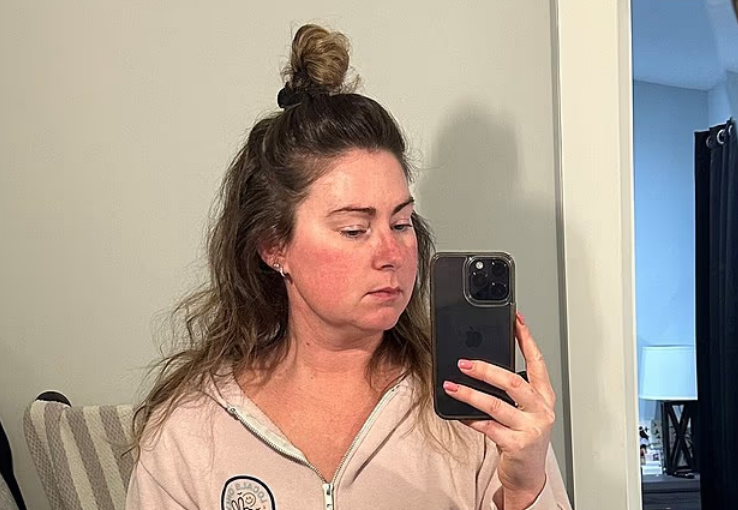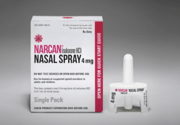
Two out of three Australian women experience discrimination in healthcare, according to recent government research. For Katelyn Bonacasa, that statistic became a devastating reality when doctors dismissed her alarming symptoms as 'just postpartum changes' for eight crucial months.
What started as a simple rash after childbirth quickly evolved into something far more sinister. Her face swelled into a perfect circle, her hair fell out in chunks, and her energy vanished completely.
Yet multiple specialists told this 30-year-old New York mother that her dramatic physical transformation was 'normal for women.'
The truth was far more serious: a rare brain tumour was flooding her body with dangerous levels of stress hormones, slowly destroying her health while doctors looked the other way.
When your body becomes unrecognisable
'My face lost all shape and became a complete circle,' Katelyn recalls of her frightening transformation. 'It was red, burning hot all the time, and then my hair began falling out.'
Within weeks of the initial rash clearing, far more troubling symptoms appeared. She lost nearly a third of her hair while coarse new growth sprouted across her face from forehead to chin. Acne erupted, her skin bruised at the slightest touch, and minor cuts took months to heal.
'I was unrecognisable. I gained 30lbs so quickly, couldn't keep my eyes open from fatigue but also couldn't sleep.'
The physical changes were matched by equally devastating psychological symptoms. 'I was depressed, anxious, angry, constantly on edge. I felt like I was losing my mind,' she explains.
Her periods stopped, her thyroid appeared enlarged, and blood tests revealed developing insulin resistance—a warning sign that her body could no longer process sugar properly.
The Australian reality: When doctors don't listen
Katelyn's experience reflects a troubling pattern documented by Australian researchers. Each year in Australia, approximately 140,000 diagnostic errors occur, resulting in estimated 21,000 serious injuries and between 2,000 to 4,000 deaths.
Communication is a contributing factor in up to 80 per cent of diagnostic errors. [1]
It is unacceptable that two thirds of women experience bias and discrimination in Australia's health system. We know that bias against women in the health system leads to poorer health outcomes. [2]
For eight months, Katelyn encountered the same dismissive responses that plague women across Australia.
'I couldn't even get a sentence out before my first endocrinologist interrupted me to say, 'You're fine',' she said. He ordered only basic thyroid tests and wrote in his notes that he had 'no suspicion of anything.'
Consistent themes included feeling dismissed and disbelieved; being stereotyped as 'hysterical' and a 'drama queen'.
Women reported that their symptoms and pain were often attributed to other causes such as menstruation, lifestyle factors or even 'faking it'. [3]
Another doctor brushed off her skin changes as adult acne. A specialist even suggested she try running on a treadmill. 'These things are normal as a woman,' one endocrinologist told her flatly.
The rare culprit: Cushing's disease in Australia
Determined to find answers, Katelyn began researching her symptoms. The more she read, the more convinced she became that she had Cushing's disease—a rare hormonal disorder that affects her daily life in Australia.
Around 300 to 1,600 Australians are living with Cushing's disease. [4] The most common cause of Cushing's syndrome is a pituitary gland tumour (aka ACTH-dependent Cushing disease), which accounts for almost 70 per cent of cases. [5]
Tests confirmed her suspicion. Her cortisol levels were three to four times higher than normal, with a 24-hour urine test showing 720 when the healthy range is between 3 and 45.
What is Cushing's disease?
Cushing's disease is a condition that occurs when a tumour in the pituitary gland causes the body to produce too much of the hormone cortisol. [6]
The tumour causes the gland to pump out excess hormones, flooding the body with cortisol and wreaking havoc on multiple body systems.
Diagnosing Cushing's disease can be difficult. Not only are many of the symptoms common in other conditions but tumours in the pituitary causing Cushing's disease are typically small. Furthermore, symptoms can also progress very slowly, making changes difficult to notice by patients and family. [7]
The telltale signs doctors miss
While cortisol is essential in small doses for regulating blood pressure, blood sugar, metabolism and immune response, sustained high levels wreak havoc throughout the body.
The classic symptoms create a distinctive pattern that medical professionals should recognise:
Patients often experience rapid weight gain concentrated around the trunk while arms and legs remain thin. The face becomes rounded—the classic 'moon face' - and fat can build up between the shoulders forming a 'buffalo hump.'
Skin thins and bruises easily, purple stretch marks appear across the abdomen, and hair growth changes dramatically. Muscles waste away, leaving profound weakness.
The psychological impact can be equally devastating. Excess cortisol affects mood and memory, raising the risk of depression, anxiety and even psychosis.
Blood pressure soars, insulin resistance develops, and patients may progress to full diabetes.
Fighting for your health: Self-advocacy strategies
Katelyn's story demonstrates the crucial importance of self-advocacy in Australia's healthcare system.
One of the most effective ways to decrease the risk of a delayed diagnosis or misdiagnosis is for women to proactively advocate for themselves with their healthcare providers. [8]
Essential self-advocacy strategies
- Document all symptoms with dates and severity levels
- Research your symptoms but present findings respectfully
- Request specific tests and ask for reasons if denied
- Seek second opinions without apology
- Bring a support person to appointments
- Ask for written explanations of dismissals
Professor Ashley Grossman, an endocrinologist at the University of Oxford, explains the diagnostic challenge: 'Cushing's can be difficult to diagnose because many of the features—weight gain, mood changes, acne—are so common. But when they occur together, and in a relatively short space of time, it should raise a red flag.'
No single test can be used to diagnose Cushing's disease. [9] However, simple blood or urine tests can provide the first crucial clues, and early diagnosis makes treatment significantly more effective.
The path to recovery
A brain scan eventually revealed a 1.5cm tumour on Katelyn's pituitary gland. In a delicate operation performed through her nasal cavity, surgeons successfully removed it.
Most patients respond well to surgery, though some require ongoing medication to suppress cortisol production or, in severe cases, removal of the adrenal glands. Recovery can be slow—it may take months or even years for cortisol levels to return to normal and for the body to heal completely.
Did you know?
Did you know?
Cushing's disease can come back after treatment. [10] There is a high recurrence rate in people with Cushing's disease. Life-long monitoring is essential. [11] This makes ongoing medical care and self-advocacy even more important for Australian patients.
Today, Katelyn shares her recovery journey on TikTok, reaching thousands with videos about her symptoms, diagnosis, and the medical dismissals she faced. 'I was the one who connected the dots and pushed for the right tests,' she emphasises.
Australian resources and support
For Australian patients facing similar challenges, several organisations provide crucial support and information:
Australian Support Resources
Australian Pituitary Foundation: pituitary.asn.au (specialist fact sheets and support)
Hormones Australia: hormones-australia.org.au (comprehensive hormone health information)
Australian Women's Health Alliance: australianwomenshealth.org (advocacy and resources)
Healthdirect: healthdirect.gov.au (government health information service)
In 2022, the Australian Government established the National Women's Health Advisory Council, recognising systemic medical misogyny as a critical problem and urgent challenge for healthcare delivery in Australia. [12]
A message of hope and determination
Since sharing her story publicly, Katelyn has received hundreds of messages from people worried they may have similar symptoms. 'It makes me sad that people have to dig through external sources and fight so hard for answers when something as simple as a blood test could change everything,' she reflects.
Her experience serves as both a warning and an inspiration. 'A 1.5cm pituitary tumour absolutely wrecked me. Nothing will humble you more than living as a version of yourself you don't recognise. But this too shall pass—it gets better.'
The key message for Australian women facing medical dismissal is clear: trust your instincts and keep pushing. 'I trusted myself, and that's what saved me,' Katelyn emphasises. 'For months I was told it was all in my head. But I knew my body, and I kept pushing. If my story helps just one person get diagnosed earlier, it will have been worth it.'
Health Disclaimer: The information in this article is for educational purposes only and should not replace professional medical advice. If you're experiencing concerning symptoms, consult your GP and consider requesting comprehensive hormone testing. Don't hesitate to seek second opinions if you feel your concerns aren't being taken seriously.
Have you or someone you know faced similar challenges getting a proper diagnosis in Australia's healthcare system? What strategies helped you advocate for better care? Share your experiences and tips in the comments below—your story might help another reader get the answers they need.
Original Article
https://www.dailymail.co.uk/health/article-15159007/puffy-red-moon-hidden-tumour.html
Lost in Diagnosis: Navigating the communication challenge of misdiagnosis in women | Australian National University
Cited text: Each year in Australia, approximately 140,000 diagnostic errors occur, resulting in estimated 21,000 serious injuries and between 2,000 to 4,000 death...
Excerpt: Each year in Australia, approximately 140,000 diagnostic errors occur, resulting in estimated 21,000 serious injuries and between 2,000 to 4,000 deaths.
https://www.anu.edu.au/events/lost-...munication-challenge-of-misdiagnosis-in-women
2 out of 3 women experience discrimination in healthcare | Health, Disability and Ageing Ministers | Australian Government Department of Health, Disability and Ageing
Cited text: “It is unacceptable that two thirds of women experience bias and discrimination in Australia’s health system.“We know that bias against women in the h...
Excerpt: It is unacceptable that two thirds of women experience bias and discrimination in Australia's health system.
https://www.health.gov.au/ministers...men-experience-discrimination-in-healthcare-0
2 out of 3 women experience discrimination in healthcare | Health, Disability and Ageing Ministers | Australian Government Department of Health, Disability and Ageing
Cited text: Consistent themes included feeling dismissed and disbelieved; being stereotyped as ‘hysterical’ and a ‘drama queen’. Women reported that their symptom...
Excerpt: Consistent themes included feeling dismissed and disbelieved; being stereotyped as 'hysterical' and a 'drama queen'.
https://www.health.gov.au/ministers...men-experience-discrimination-in-healthcare-0
Australian Pituitary Foundation Fact Sheet | Cushing’s Disease 1 of 4
Cited text: Around 300 to 1,600 Australians are living with Cushing’s disease.
Excerpt: Around 300 to 1,600 Australians are living with Cushing's disease.
https://pituitary.asn.au/wp-content/uploads/2023/09/APF-Cushings-Fact-Sheet-2023_Digital.pdf
Cushing’s Syndrome | Ausmed
Cited text: 2023; Pathology Tests Explained 2023) The most common cause of Cushing’s syndrome is a pituitary gland tumour (aka ACTH-dependent Cushing disease), wh...
Excerpt: The most common cause of Cushing's syndrome is a pituitary gland tumour (aka ACTH-dependent Cushing disease), which accounts for almost 70 per cent of cases.
https://www.ausmed.com.au/learn/articles/cushings-syndrome
Cushing’s Disease—Hormones Australia
Cited text: Cushing’s disease is a condition that occurs when a tumour in the pituitary gland causes the body to produce too much of the hormone cortisol.
Excerpt: Cushing's disease is a condition that occurs when a tumour in the pituitary gland causes the body to produce too much of the hormone cortisol.
https://www.hormones-australia.org.au/endocrine-diseases/cushings-disease/
Cushing’s Disease—Hormones Australia
Cited text: Diagnosing Cushing’s disease can be difficult.Not only are many of the symptoms common in other conditions but tumours in the pituitary causing Cushin...
Excerpt: Diagnosing Cushing's disease can be difficult. Not only are many of the symptoms common in other conditions but tumours in the pituitary causing Cushing's disease are typically small.
https://www.hormones-australia.org.au/endocrine-diseases/cushings-disease/
How women can avoid misdiagnosis
Cited text: One of the most effective ways to decrease the risk of a delayed diagnosis or misdiagnosis is for women to proactively advocate for themselves with th...
Excerpt: One of the most effective ways to decrease the risk of a delayed diagnosis or misdiagnosis is for women to proactively advocate for themselves with their healthcare providers.
https://www.pinnaclecare.com/blog/womens-self-advocacy-misdiagnosis/
Cushing’s Disease—Hormones Australia
Cited text: No single test can be used to diagnose Cushing’s disease.
Excerpt: No single test can be used to diagnose Cushing's disease.
https://www.hormones-australia.org.au/endocrine-diseases/cushings-disease/
Cushing's syndrome—symptoms, treatments and causes | healthdirect
Cited text: Cushing's disease can come back after treatment.
Excerpt: Cushing's disease can come back after treatment.
https://www.healthdirect.gov.au/cushings-syndrome
Australian Pituitary Foundation Fact Sheet | Cushing’s Disease 1 of 4
Cited text: There is a high recurrence rate in people with Cushing’s disease. Life-long monitoring is essential ...
Excerpt: There is a high recurrence rate in people with Cushing's disease. Life-long monitoring is essential.
https://pituitary.asn.au/wp-content/uploads/2023/09/APF-Cushings-Fact-Sheet-2023_Digital.pdf
It's time to stop gaslighting women when it comes to their health
Cited text: In 2022, the Australian Government established the National Women’s Health Advisory Council, recognising systemic medical misogyny as a critical probl...
Excerpt: In 2022, the Australian Government established the National Women's Health Advisory Council, recognising systemic medical misogyny as a critical problem and urgent challenge for healthcare delivery in Australia.
https://reporter.anu.edu.au/all-sto...slighting-women-when-it-comes-to-their-health







